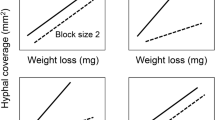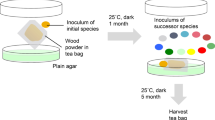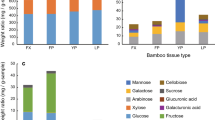Abstract
HYPHAE of fungi that decay wood spread rapidly through their host substrate before any significant loss of weight is detectable1. Indeed, the rate of advance of Fomes annosus over or through red pine was identical with its growth rate over malt-agar plates2 even though fungi that decay wood develop more slowly on cellulose than, on simple sugars3. Glucose stimulates growth over wood4, and laboratory cultures provided with a choice of cellulose or a simple carbon source preferentially utilize the latter5,6, for enzymes that hydrolyse cellulose are generally only produced when growth is restricted7. These data suggest, as expected, that fungi initially colonize wood chiefly by utilizing non-structural carbohydrates. Such materials would include simple sugars which have been identified in the sapwood of both hardwoods8 and softwoods9 and which in the latter account for 0.03 to 0.8 per cent of the dry weight; figures for the inner bark are, of course, considerably higher. Polysaccharides such as starch may also be utilized rapidly: ray cells often provide entrance for invading hyphae and starch reserves of these cells were quickly exhausted, for example, during early decay of sweetgum sapwood by Poria monticola10. Traces of polysaccharides grouped with holocellulose may also be readily available and thus utilized early in the decay process11.
This is a preview of subscription content, access via your institution
Access options
Subscribe to this journal
Receive 51 print issues and online access
$199.00 per year
only $3.90 per issue
Buy this article
- Purchase on Springer Link
- Instant access to full article PDF
Prices may be subject to local taxes which are calculated during checkout
Similar content being viewed by others
References
Gillespie, T., and Hulme, M. A., Nature, 225, 102 (1970).
Thompson, J. H., Cowling, E. B., and Ross, E. W., Canad. J. Bot., 46, 1533 (1968).
Henningsson, B., Studia Forestalia Suecica, 52 (1967).
Findlay, W. P. K., Ann. Appl. Biol., 28, 19 (1941).
Bravery, A. F., J. Sci. Food Agric., 19, 133 (1968).
Siu, R. G. H., in Microbial Decomposition of Cellulose, 201 (Reinhold, New York, 1951).
Hulme, M. A., and Stranks, D. W., Nature, 226, 429 (1970).
Larsson, S. E., and Selleby, L., Svensk Papperstidn., 63, 18 (1960).
Smith, L. V., and Zavarin, E., Tech. Assoc. Pulp Paper Indust., 43, 218 (1960).
Wilcox, W. W., US Forest Service Research Paper FPL 70 (US Department of Agriculture, Forest Products Laboratory, Madison, Wisconsin, 1968).
Merrill, W., and French, D. W., Phytopathology, 54, 867 (1964).
Levy, J. F., in Biodeterioration of Materials (edit. by Walters, A. H., and Elphick, J. J.), 424 (Elsevier, Amsterdam, London, New York, 1968).
Zycha, H., Holz als Roh-und Werkstoff, 22, 37 (1964).
Greaves, H., and Savory, J. G., J. Inst. Wood Sci., No. 15, 45 (1965).
Kerner-Gang, W., Material und Organismen, 1, 297 (1966).
Persson-Huppel, A., Studia Forestalia Suecica, 4 (1963).
Webster, J., and Lomas, N., Trans. Brit. Mycol. Soc., 47, 535 (1964).
Finstein, M. S., and Alexander, M., Soil Sci., 94, 334 (1962).
Wood, T. M., Biochim. Biophys. Acta, 192, 531 (1969).
deFreitas, A. R., and Erickson, H. D., Forest Prod. J., 19, 45 (1969).
Author information
Authors and Affiliations
Rights and permissions
About this article
Cite this article
HULME, M., SHIELDS, J. Biological Control of Decay Fungi in Wood by Competition for Non-structural Carbohydrates. Nature 227, 300–301 (1970). https://doi.org/10.1038/227300a0
Received:
Revised:
Issue Date:
DOI: https://doi.org/10.1038/227300a0
This article is cited by
-
Biological control of some wood-decay fungi with antagonistic fungi
Biodegradation (2023)
-
Decomposition of woody branch litter on an altitudinal transect in the Himalaya
Vegetatio (1986)
-
Experience with immunizing commensals
Netherlands Journal of Plant Pathology (1977)
Comments
By submitting a comment you agree to abide by our Terms and Community Guidelines. If you find something abusive or that does not comply with our terms or guidelines please flag it as inappropriate.



